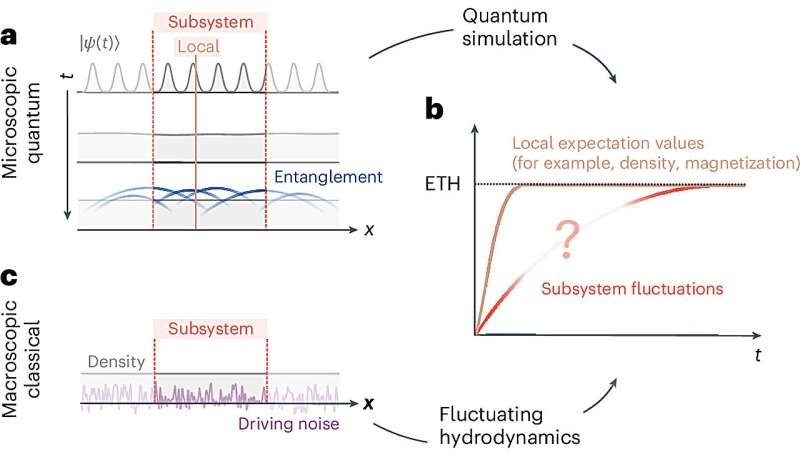Researchers have discovered that even highly complex and chaotic quantum systems can be described using simple macroscopic equations, similar to how fluid dynamics can be used to study water flow without delving into the physics of individual water molecules.

Fluctuating hydrodynamics: The weapon of mass…
Although it remains quite challenging to describe the behavior of complex systems by theoretical modeling, fluctuating hydrodynamics (FHD) has proven a useful tool even at the quantum level. This enables researchers to reduce the complexity of a system by looking only at macroscopic properties e. g., the diffusion constant rather then having to go down into all these microscopic details on every interaction level.
At the heart of FHD is an act of faith: that even when the underlying physics are messy, nonlinear and high-dimensional (and hence seemingly chaotic), they exhibit a simpler universal behaviour on longer length scales that can be summarized by one number: the diffusion constant. This immensely simplifies the macroscopic delineation of the system and removes constraint to fully comprehend about the microscopic interaction.
The researchers, led by Professor Monika Aidelsburger and Professor Immanuel Bloch from the LMU Faculty of Physics, have found indications that this FHD scheme can also be used for chaotic quantum systems — a notorious challenge known as one of the most difficult things to model in nature due to peculiarities inherent to quantum mechanics like uncertainty and entanglement.
Watch One of the First Experiment on Quantum Chaos
The research group experimentally explored the capability of FHD in a quantum chaotic system by using an ultracold cesium atom in optical lattices. If we prepare the system with a non-equilibrium intial state and allow i t to evolve freely it becomes possible to see how the dynamics of the system occur in real-time.
At the core of their experiment is a high-resolution imaging system that can not only measure the average particle density in the lattice sites, but also fluctuations around this mean density. From studying the evolution of these fluctuations and density correlations in time, the researchers established that FHD theory provides a correct qualitative and quantitative description of their quantum system.
This is a startling implication that even at the highest levels of complexity and chaos, quantum systems could nonetheless be tamed by simple macroscopic theories much like fluid dynamics can describe such complex flows of water without directly worrying about all the detailed atomic physics.
Conclusion
The realization that time-series analysis of hydrodynamics can be employed to probe chaotic quantum systems has massive implications for the fundamental integration of these two disciplines in our understanding of nature. Reduced macroscopic descriptions of such complex systems have a huge importance: they provide an easy way to extract worthwhile observations without getting stuck in the convoluted webs of microscopic interactions that motivate these interesting behaviors. Applied across the board, it could transform quantum systems from mere curiosities to well understood dynamical arrangements with implications for a host of fields pipeline from physics through materials science and more.
